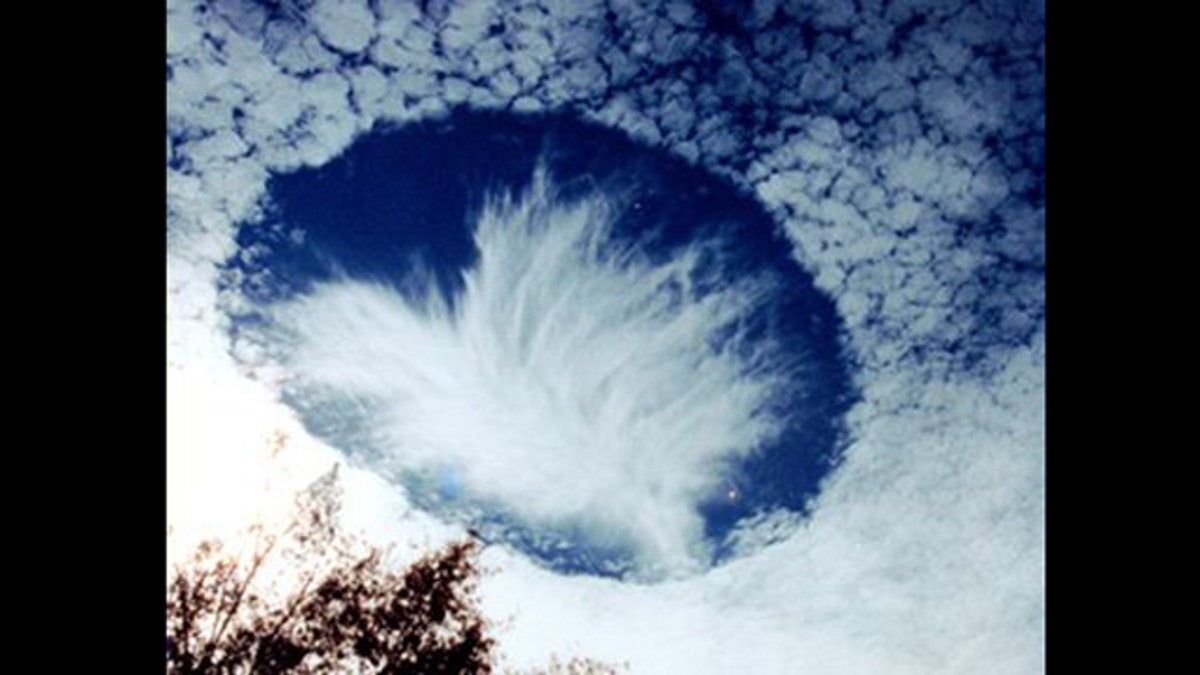
Planes can accidentally punch holes in clouds, leaving snow or rain in their wake, according to a new paper. (Joel Knain/NASA)
A few years ago scientists were surprised by the sight of two planes carving a hole through a cloud—which then began spewing snow.
A new study spawned by the accidental discovery solves the mystery behind so-called hole-punch clouds and explains how airplanes can change the weather, at least on an extremely local level.
Scientists have studied hole-punch clouds since the 1940s and have long suspected that planes play a role in their formation. (See pictures of a potentially new type of cloud.)
Now, ice microphysicist Andrew Heymsfield and colleagues have found that aircraft really can create the odd clouds. Their research also uncovered something totally new: that aircraft can unleash precipitation by carving the cloud tunnels, which had never before been observed.
(Pictures: "Night Shining Clouds Getting Brighter.")
How Planes Can Make It Rain
Clouds at a certain the right altitude and temperature—relatively common over western Europe and the U.S. Pacific Northwest, for example—are saturated with water droplets cooled to about 5 degrees Fahrenheit (minus 15 degrees Celsius).
Because the water in these clouds is so pure—with no particles around which vapor can condense and freeze—the droplets remain liquid down to minus 35 degrees Fahrenheit (minus 34 degrees C). If the cloud gets much colder, though, they freeze into ice particles that can produce rain or snow.
When a plane's propeller, for example, spins through a cloud, the propeller exerts a rearward force. The force expands air, cooling by as much as 54 degrees Fahrenheit (30 degrees Celsius), said Heymsfield, of the National Center for Atmospheric Research (NCAR) in Boulder, Colorado.
Jets do the same thing when air is forced over their wings, though jets cool air by only about 36 degrees Fahrenheit (20 degrees Celsius).
As planes push cloud temperatures past the tipping point at which supercooled water freezes, the aircraft "seed" the clouds with ice particles, the study says.
"If you introduce ice particles, water vapor will condense on them—like it does on a bathroom mirror that's just a bit cooler than the room—and then snow out" or rain out, Heymsfield explained.
(Download our weather pictures.)
Hole-Punch Cloud Discovery a Surprise
Heymsfield and colleagues flew smack-dab into the hole-punch discovery after having conducting a cloud study from a heavily instrumented turboprop plane near Denver International Airport in 2007.
A later look at ground-based radar showed an unexplained band of snowfall in the area.
"When we went back to our forward- and downward-looking video camera data, we could see a canal-like hole" in block of clouds, he said.
"And we could look down and see a snow shaft falling out of the hole to the ground."
U.S. Federal Aviation Administration records show that another turboprop followed the same path in short order. The snow squall began five minutes after the second plane had passed. Snow fell for 45 minutes along a band 20 miles (32 kilometers) long and 2.5 miles (4 kilometers) wide, dropping some two inches (five centimeters) on the ground under the band.
Because hole punching triggers dynamic events within the clouds, he added, the new research, published this month in the Bulletin of the American Meteorological Society, could improve our understanding of cloud circulation.
And the discovery could someday lead to better efforts at producing rainfall by cloud seeding (pictures of seven emergency climate fixes), he added—meaning that, for a change, the weather could be at the mercy of planes, rather than the other way around.
Read more of National Geographic's daily news on science, nature, and cultures.
